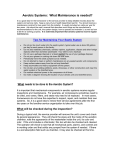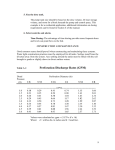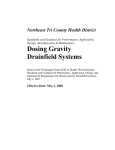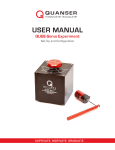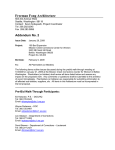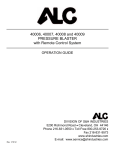Download Home Aerobic Systems
Transcript
Small Community Wastewater Issues Explained to the Public The following articles are reprinted from Pipeline, Winter 1996; Vol. 7, No. 1. Home Aerobic Wastewater Treatment: An Alternative To Septic Many homes in the U.S. are located in small or rural communities where houses are spaced widely apart. In these communities, central sewerage systems are often not cost-effective, so many homeowners rely on septic systems or other systems that treat and dispose of household wastewater onsite. Some homes for which septic systems are not a good option rely on individual home aerobic systems for wastewater treatment. Aerobic systems are similar to septic systems in that they both use natural processes to treat wastewater. But unlike septic (anaerobic) treatment, the aerobic treatment process requires oxygen. Aerobic treatment units, therefore, use a mechanism to inject and circulate air inside the treatment tank. This mechanism requires electricity to operate. For this reason, aerobic systems cost more to operate and need more routine maintenance than most septic systems. However, when properly operated and maintained, aerobic systems can provide a high quality wastewater treatment alternative to septic systems. Why choose aerobic treatment? Although there have been home aerobic systems in the U.S. for more than 50 years, their use has been fairly limited. This is due, in part, to the widespread use of septic systems. Septic tank-soil absorption systems are relatively inexpensive and are easy to maintain. They are the most common onsite wastewater treatment systems used in rural areas. However, there are many households for which a septic system may not be the best wastewater treatment option. For example, septic systems are not suitable for every lot. In fact, approximately two-thirds of all the land area in the U.S. is estimated to be unsuitable for the installation of septic systems. Some homes may not have enough land area or appropriate soil conditions to accommodate the soil absorption drainfield. In some communities, the water table is too high to allow the drainfield to give adequate treatment to the wastewater before it is returned to the groundwater. Other site-related concerns include homes located on wooded lots or on lots close to a body of water. Homeowners in wooded areas may not want to clear enough land to install a septic tank and drainfield, and the wastewater treated by a septic system is often not of high enough quality to be discharged very close to a body of water. But one of the most common reasons that aerobic wastewater treatment units are chosen by communities is to replace failing septic systems. Failing septic systems are a major source of groundwater pollution in some areas. If a failed septic system needs to be replaced or if a site is inappropriate for conventional systems, aerobic wastewater treatment becomes a viable option. This issue of Pipeline focuses on individual home aerobicunits as an alternative for onsite wastewater treatment. Please feel free to share, copy, or distribute this information to others in your community. Articles in Pipeline can be reprinted in local newspapers or included in flyers, newsletters, and educational presentations. We ask only that you send us a copy of the reprinted article for our files. If you have any questions or require further information about any of the topics in this newsletter, please contact the National Small FlowsClearinghouse at (800) 624-8301. Are Aerobic Systems Right for My Community? Aerobic treatment systems are not accepted in all areas. Regulations for onsite systems can vary from state to state and from one local government to the next. One possible reason that the acceptance of aerobic systems has been slow in some communities may be that local regulators don't have much experience with them. Unless aerobic systems are already in use locally, there is little opportunity for officials to become familiar with their performance in different situations. A major reason that aerobic systems are not more widely used is concern about improper operation and maintenance by homeowners. Aerobic systems require regular maintenance, and abuse or neglect can easily lead to system failure. In answer to these concerns, NSF International (formerly the National Sanitation Foundation) has tested aerobic units according to the requirements of ANSI/NSF Standard 40. NSF International is a nonprofit organization devoted to the protection of public health and the environment through the development of product standards, product evaluations, research, education, and training. The American National Standards Institute (ANSI) is the recognized accreditor in the U.S. for organizations that develop consumer standards and for those that provide independent product evaluations. NSF is accredited by ANSI for both of these areas of service. Aerobic units that satisfy the requirements of ANSI/NSF Standard 40 may carry the NSF mark. In addition to testing their units, NSF requires manufacturers to include the cost of the first two years of service in the price of purchase. During this initial service contract, each piece of equipment must be serviced a minimum of two times per year, and emergency service must be available to the homeowner. Manufacturers must also offer the homeowner the option of renewing the service contract after the two years. In most cases, the service contract is carried out by the dealer selling the aerobic unit, who represents the manufacturer. Standard 40 details what type of service is to be performed and what records need to be kept. Both the manufacturers and their distributors are inspected annually by NSF to ensure continued compliance with the requirements. (For more information, read the article Aerobic System Maintenance). Some state and local governments that allow aerobic treatment require that units carry the NSF approval. Your local health department will be familiar with the regulations and permit requirements for your area, as well as which onsite options are best for your particular property. (To inquire about regulations or permit requirements in your area, contact your local health department.) Aerobic Treatment Pros and Cons Advantages • • • • • Can provide a higher level of treatment than a septic tank Helps to protect valuable water resources where septic systems are failing Provides an alternative for sites not suited for septic systems May extend the life of a drainfield May allow for a reduction in drainfield size Disadvantages • • • • More expensive to operate than a septic system Requires electricity Includes mechanical parts that can break down Requires more frequent routine maintenance than a septic tank • • Subject to upsets under sudden heavy loads or when neglected May release more nitrates to groundwater than a septic system How Aerobic Treatment Works Aerobic systems treat wastewater using natural processes that require oxygen. Bacteria that thrive in oxygen-rich environments work to break down and digest the wastewater inside the aerobic treatment unit. Like most onsite systems, aerobic systems treat the wastewater in stages. Sometimes the wastewater receives pretreatment before it enters the aerobic unit, and the treated wastewater leaving the unit requires additional treatment or disinfection before being returned to the environment. Such a variety of designs exist for home aerobic units and systems that it is impossible to describe a typical system. Instead, it is more practical to discuss how some common design features of aerobic systems work and the different stages of aerobic treatment. Pretreatment Some aerobic systems include a pretreatment step to reduce the amount of solids in the wastewater going into the aerobic unit. Solids include greases, oils, toilet paper, and other materials that are put down the drain or flushed into the system. Too much solid material can clog the unit and prevent effective treatment. Some pretreatment methods include a septic tank, a primary settling compartment in the treatment unit, or a trash trap. Pretreatment is optional but can greatly improve a unit's performance. Aerobic Treatment Units The main function of the aerobic unit is to collect and treat household wastewater, which includes all water from toilets, bathtubs, showers, sinks, and laundry. Aerobic units themselves come in many sizes and shapes-rectangular, conical, and some shapes that defy classification. Figure 1 on this page and figure 2 on page 4 show two aerobic unit design possibilities. Suspended Growth Units The process most aerobic units use to treat wastewater is referred to as suspended growth. These units include a main compartment called an aeration chamber in which air is mixed with the wastewater. Since most home aerobic units are buried underground like septic tanks, the air must be forced into the aeration chamber by an air blower or a compressor. The forced air mixes with wastewater in the aeration chamber, and the oxygen supports the growth of aerobic bacteria that digest the solids in the wastewater. This mixture of wastewater and oxygen is called the mixed liquor. The treatment occurring in the mixed liquor is referred to as suspended growth because the bacteria grow as they are suspended in the liquid unattached to any surface. Unfortunately, the bacteria cannot digest all of the solids in the mixed liquor, and these solids eventually settle out as sludge. Many aerobic units include a secondary chamber called a settling chamber or clarifier (see figure 1) where excess solids can settle. Other designs allow the sludge to accumulate at the bottom of the tank (see figure 2 on page 4). In aerobic units designed with a separate settling compartment, the sludge returns to the aeration chamber (either by gravity or by a pumping device). The sludge contains bacteria that also aid in the treatment process. Although, in theory, the aerobic treatment process should eventually be able to consume the sludge completely, in practice, the sludge does build up in most units and will need to be pumped out at least once a year so that solids don't clog the unit. Attached Growth Units An alternative design for aerobic treatment is the attached growth system. These units treat wastewater by taking a surface made of material that the bacteria can attach to, and then exposing that surface alternately to wastewater and air. This is done either by rotating the surface in and out of the wastewater or by dosing the wastewater onto the surface. Pretreatment is required. The air needed for the process is either naturally present or is supplied mechanically. Attached growth systems, such as trickling filters and rotating disks, are less common than suspended growth systems, but have certain advantages. For example, there is no need for mixing, and solids are less likely to be washed out of the system during periods of heavy household water use. Flow Design The way and the rate in which wastewater is received by and flows through the aerobic unit differs from design to design. Continuous flow designs simply allow the wastewater to flow through the unit at the same rate that it leaves the home. Other designs employ devices (such as pretreatment tanks, surge chambers, and baffles) to control the amount of the incoming flow. Batch process designs use pumps or siphons to control the amount of wastewater in the aeration tank and/or to discharge the treated wastewater in controlled amounts after a certain period of time. Controlling the flow of wastewater helps to protect the treatment process. When too much wastewater is flushed into the system all at once, it can become overburdened, and the quality of treatment can suffer. The disadvantages to mechanical flow control devices are that, like all mechanical components, they need maintenance and run the risk of malfunctioning. Homeowners can help their system's performance by conserving water. Leaking faucets and running toilets should be repaired, and washing machines and dishwashers should be used only when full. Installing water saving devices in toilets, faucets, and showers can reduce water use by up to 50 percent. Also, homeowners should try to space out activities requiring heavy water use (like laundry) to avoid overloading their systems. Final Treatment and Disposal Although properly operated and maintained aerobic units are very effective, the wastewater leaving the units is not ready to be returned to the environment and must receive final treatment or disinfection. Methods for final treatment include discharge to a soil absorption field, a sand filter, or an evapotranspiration bed. Sometimes, the wastewater receives disinfection before being discharged to the soil or directly to a body of water. Your health department is familiar with local regulations and the treatment options that are best in your area and for your property. Soil absorption fields (or drainfields) are the most common method of final treatment used for septic systems. If an aerobic system is being used in place of a septic system or to replace a failing septic system, a drainfield may not be an option. However, an aerobic unit can sometimes help to prolong the life of a drainfield. The amount of dissolved oxygen contained in wastewater from an aerobic unit can help the growth of microorganisms that treat the wastewater in the soil, and can help prevent the pores in the soil from clogging. However, when aerobic units malfunction, they can release solids that can clog the drainfield, which may cancel out any potential benefits. Evapotranspiration beds are a less common method of final treatment and use vegetation and evaporation to naturally treat the wastewater. Drip irrigation is another less commonly used method to treat and dispose of wastewater. Sand filters are sometimes used to treat the wastewater from aerobic units. The wastewater is pumped evenly over several layers of sand and gravel, which are located either above or below ground. As with soil treatment systems, the purification process is aided by bacteria that occur naturally in the sand. Disinfection is another method of treatment commonly used with aerobic units. Some units have the disinfection process incorporated into the unit design. In some cases, disinfection may be the only treatment required of the wastewater from an aerobic unit before the water is released into the environment. One disadvantage of this method is the added cost of the disinfectants, such as chlorine. Other Design Considerations Controls and Alarms Most aerobic units have controls that can be switched on and off by the homeowner in case of emergency. Aerobic units also are required to have alarms to alert the homeowner of malfunctions. Depending on the design of the system, controls and alarms can be located either inside or outside the home, and alarms can be visible, audible, or both. Homeowners should make sure that controls and alarms are always protected from corrosion, and that the aerobic unit is turned back on if there is a power outage or if it is turned off temporarily. Size Aerobic units should be large enough to allow enough time for the solids to settle and for the wastewater to be treated. The size of most units range from 300 to 1,500 gallons per day, but local regulations often require that the unit be at least large enough to handle 500 gallons of wastewater per day. The needed size of an aerobic unit is often estimated the same way the size of a septic tank is estimated, by the number of bedrooms (not bathrooms) in the house. It is assumed that each person will use approximately 50 to 100 gallons of water per day, and that each bedroom can accommodate two people. When calculated this way, a three-bedroom house will require a unit with a capacity of 300 to 600 gallons per day. Some health departments require that aerobic units be sized at least as large as a septic tank in case the aerobic unit malfunctions and oxygen doesn't mix with the wastewater. In such cases, the aerobic unit will work as a septic tank-which will, at least, provide partial treatment for the wastewater. Temperature Lower temperatures tend to slow down most biological processes, and higher temperatures tend to speed them up. The aerobic process itself creates heat, which, along with the heat from the electrical components, may help to keep the treatment process active. However, cold weather can have adverse effects on the performance of aerobic units. In one study of aerobic units, there were problems when the temperature of the wastewater inside some of the units fell below 15 degrees Celsius (59 degrees Farenheit). Problems can sometimes be avoided by insulating around the units. Your health department should know whether aerobic systems are suitable for your area. Aerobic System Do's and Don'ts • • • • • • • • • • • • • Do maintain the contract service arrangement offered by the manufacturer after the initial two-year period has expired (unless your community offers its own management program). It is extremely important that aerobic systems receive regular maintenance. Do keep your system accessible for inspections and pumping, yet protected from unauthorized entrance. If access to your system is locked, make sure that your service contractor has a key. Do call a service professional whenever you experience problems with your system, whenever the alarm is activated, or whenever there are any signs of system failure. Do keep detailed records about your aerobic system, including a map of where it is, and general information, such as model name, capacity, state license, date installed, contract service agreement, records of service visits, and maintenance performed. Do conserve water to avoid overloading the system. Be sure to repair any leaky faucets or toilets. Do divert other sources of water, like roof drains, house footing drains, and sump pumps away from the aerobic system. Do become familiar with how your own particular system operates, and the way it looks, sounds, and smells when it is working correctly. This way, you may be able to identify problems before they become serious and alert your service provider to anything unusual. Do be sure to ask your service provider questions about how to know if your unit is malfunctioning. Don't allow anyone to drive over or park on any part of the system. Don't make or allow unauthorized repairs or changes to your aerobic system without obtaining the required health department permits. Don't use your toilet as a trash can or poison your treatment system and the groundwater by pouring harmful chemicals down the drain. Harsh chemicals can kill the beneficial bacteria that treat your wastewater. Don't use a garbage disposal without checking with your local regulatory agency to make sure that your aerobic system can accommodate this additional waste. Don't attempt to clean or perform maintenance on any sealed aerobic unit or any sealed aerobic unit components. Do Not Flush… • • • • • • • • • • • • • • • coffee grounds dental floss disposable diapers kitty litter sanitary napkins tampons cigarette butts condoms gauze bandages fat, grease, or oil paper towels And never flush chemicals, such as: paints varnishes thinners • • • waste oils photographic solutions pesticides These items can overtax or destroy the biological digestion taking place within your system. Warning Signs of Aerobic System Problems ! Alarms or lights going off ! Any changes in the system's normal operating sound ! Any changes in the normal color of the wastewater in the aeration chamber (for example, if the color is greyish brown rather than chocolate brown, this can sometimes indicate problems) ! Excessive solids, foam, or scum in the unit ! Plumbing backups ! Sewage odors in the house or yard Aerobic System Maintenance It is important that mechanical components in aerobic systems receive regular inspection and maintenance. For example, air compressors sometimes need to be oiled, and vanes, filters, and seals may need to be replaced. Malfunctions are common during the first few months after installation. In most cases, homeowners do not have the expertise to inspect, repair, and maintain their own systems. If your unit carries the NSF approval, it will include the first two years of service visits with the purchase price and an option to renew the service contract after two years. It is a good idea for homeowners to renew their service agreements after two years, or to find another service organization to take over the job. In addition to routine maintenance, NSF requires service contractors to stock replacement parts for mechanical components and to be available for emergency servicing. Under the original two-year agreement, failed equipment is replaced at no additional cost to the homeowner. The service contract may or may not cover such problems as damage from power failures, breaking or crushing of pipes leading to and from the system, flooding, fires, homeowner misuse, and other catastrophies beyond the control of the manufacturer. Service visits will most likely be carried out by the dealer or another independent service organization that has an agreement with the manufacturer. In other cases, health departments will have maintenance management programs, such as sanitary districts, for aerobic systems and other onsite systems in their area. What To Expect at a Typical Service Visit The first service visit should be scheduled immediately after the system is installed to make sure that everything is working correctly. The service contractor may also arrange a meeting with the homeowner to go over issues, such as proper operation, what to do in case of emergency, etc. For seasonal properties, homeowners will need to know how to shut the system down in the off season and start it again when needed. After the first visit, the maintenance service contract is issued to the homeowner. The maintenance contract may include at least two service visits per year for the next two years. The number of visits and service performed will differ from unit to unit and location to location depending on manufacturers' recommendations and local regulations. During a typical visit, the service provider will remove the unit's cover and check its general appearance. He or she will check pipes and the inside of the aeration chamber, and will note the appearance of the wastewater inside the unit and its color and odor. If the unit includes a chlorinator, this too will be checked and may be cleaned. Samples may be taken of the mixed liquor from the aeration chamber, as well as the final treated wastewater. The operator will also check to see that all mechanical parts, alarms, and controls are in working order, and that solids are pumped from the system if needed. The soil absorption field, sand filter, or other method of final treatment may also be inspected by the service provider. Record Keeping It is a good idea for the homeowner or the service provider to keep detailed records about the system and service visits. NSF-approved units are required to include a user's manual that describes such things as the manufacturer's recommendations for the unit, the system design, how to operate and maintain it, as well as how to tell if it is working properly. The state license, the date the system was installed, the type of disinfection, and any modifications to the system should also be recorded. Other important information to keep on hand includes where to contact the owner if nobody is home, where to find a key to the system, and the schedule for service visits. Homeowners should keep their own copies of all records and permits. Q&A: How Much Does Aerobic Treatment Cost? The cost of aerobic treatment varies depending on factors, such as design, size, location, and operation and maintenance requirements. Some of the factors affecting the cost of aerobic treatment are as follows: • • • • • • Unit price, Cost of unit installation and electricians' fees, Cost of construction of the drainfield or cost of other method of additional treatment if required, Cost of electricity (per year), Maintenance service contract fee (per year), and Cost of disinfection (if applicable). The price of some of these factors, such as unit price, may be adversely affected by the lack of demand for aerobic systems in certain areas. Installation costs may be higher for aerobic units than for septic tanks because of the electrical work required. All of these factors need to be carefully considered when determining the cost-effectiveness of aerobic treatment versus other treatment methods. Your local health official can help you evaluate your options. Contacts NSF International (formerly the National Sanitation Foundation) NSF International is a private, nonprofit organization devoted to research, education, service, and training that tests and publishes standards for products relating to public health and the environment. To order the ANSI/NSF Standard 40, see the listing at the bottom of this page. For more information, you may contact NSF at (800) NSF-MARK. Health Department Homeowners interested in home aerobicwastewater treatment units or other onsite systems should contact their local health department for more information about local regulations and requirements. (Health departments are usually listed in the government section or blue pages of local phone directories.) National Small Flows Clearinghouse (NSFC) The National Small Flows Clearinghouse (NSFC), located at West Virginia University, is a good contact for homeowners and community officials for more information about home aerobic units, septic systems, and alternative systems. The NSFC is funded by the U.S. Environmental Protection Agency and offers technical assistance and a variety of free and low-cost products to help small communities with wastewater issues. Some of these NSFC products are listed on the back page. You may contact the NSFC at (800) 624-8301. Return to Septic Technology Home






